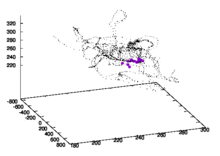- thermal particles
- energetic non-thermal particles
- magnetic fields.
The relationship between these ingredients is nuanced and interesting. By number, non-thermal particles are many orders of magnitude less abundant than their more populous thermal-population counterpart.
However, by energy, their population constitutes a significant fraction of total energy within both Galactic and Extragalactic regions. The exchange of energy between these two particle components, however, is only possible due to the presence of the magnetic fields. Instead of communicating via direct collisions between these two particle pools (the rates of which are negligibly small) the magnetic fields also embedded act as a mediator between them.
An explanation for the existence of this non-thermal particle population, and magnetic fields, at the levels observed is one of the areas of research of the group. An understanding of it demands a self- consistent description of both the production rates from their sources and their subsequent energy loss/ decay rates during their transport into the much larger Galactic and Extragalactic volumes. Such a description requires that the coupling of the particles to the field be taken into account, calling on the use of numerical simulations (using, e.g., Magneto-Hydrodynamics (MHD) and Particle-in-Cell (PIC) techniques).





